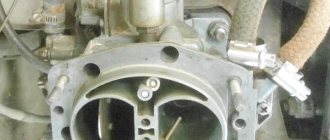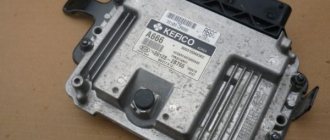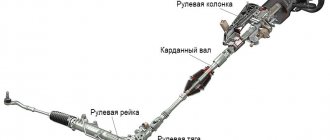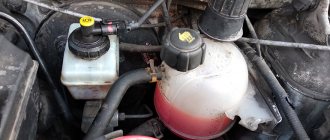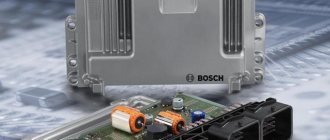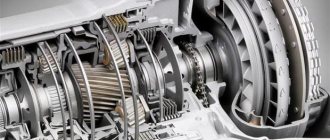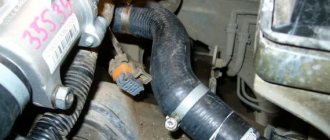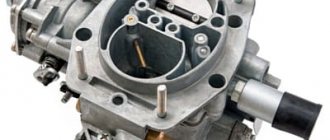What is VVT-i on Toyota
First, let's remember how gas distribution works on conventional engines.
During the intake phase, the cylinder is filled with an air-fuel mixture through the opened intake valve, after which the phase of its compression by the piston begins. During the power stroke phase, the mixture ignites, and during the exhaust phase, it is removed from the cylinder through the opened exhaust valve. In theory it’s quite simple, but in practice a number of problems arise. So, motorists want more power, efficiency and environmental friendliness at the same time, but these desires contradict each other. After all, to increase power, you need to keep the intake valve open longer so that the cylinder receives more fuel mixture. At the same time, the efficiency and purity of the exhaust naturally decreases. Finding the golden mean is very difficult due to the fact that engine operating conditions are constantly changing.
There is also a more prosaic problem - the valve timing does not work instantly, but with some delay. For example, some, albeit rather short, time passes between the opening of the intake valve and the intake of the fuel mixture. And these delays vary depending on the speed and other factors. It is almost impossible to make a fixed, highly efficient gas distribution setting under such conditions.
Therefore, in 1996, Toyota introduced VVT-i into its engines, an intelligent valve timing system that adjusts timing settings on the fly, depending on the current operating conditions of the engine. The first generation VVT-i allowed for tangible improvements:
- power and torque increased by 10% on average;
- fuel consumption in the urban cycle decreased by 6-8 percent;
- the concentration of nitrogen oxide in the exhaust dropped by 40%;
- improved car behavior at low speeds;
- more efficient use of turbocharging.
Timing faults
Main malfunctions of the gas distribution mechanism:
- Reducing compression and popping in pipelines. As a rule, it occurs after the appearance of carbon deposits, shells on the surface of the valve, and their burnout, which is caused by a loose fit of the intake and exhaust valves to the seats. Factors such as cylinder head deformation, breakage or wear of springs, jamming of the valve stem in the bushing, and a complete lack of space between the rocker arm and the valves also have an impact.
- Reduced power, engine tripping, and metallic knocks. These symptoms appear because the intake and exhaust valves do not open completely, and part of the air-fuel mixture does not enter the combustion chamber of the cylinder. The consequence of this is a large thermal gap or breakdown of the hydraulic compensator, which causes a malfunction and improper operation of the valves.
- Mechanical wear of parts, such as: crankshaft guide bushings, camshaft gears, as well as camshaft displacement. Mechanical wear of parts, as a rule, occurs when the engine has been operating for a sufficient period of time and the engine is operating within critical limits.
- Engine failure also occurs due to wear of the toothed belt, which has its own warranty period, the chain, which becomes less efficient after a long period of operation and constant exposure to it, the chain guide and the toothed belt tensioner.
In these cases, it is not uncommon to replace the gas distribution mechanism, but it is also possible to repair a damaged part of the gas distribution mechanism.
How VVT-i works
There are several conventional generations of the system, their structure differs somewhat in detail. But in general, the operating principle of the VVT-i system is the same. The VVT-i drive is located in the camshaft pulley. In this case, the drive housing is connected to a sprocket or toothed pulley, and the drive rotor is connected to the camshaft. Oil is supplied to the drive from one or the other side of each of the rotor blades. As a result, the rotor and camshaft rotate to the desired angle.
What is Dual VVT-i and VVT-iE
Of course, Toyota did not stop there and improved the dynamic gas distribution system. The next evolutionary stage was the Dual VVT-i system, which learned to control the camshaft of not only the intake but also the exhaust valves. The latest modification is VVT-iE, its differences are much deeper. Thus, the adjustment of the rotation angles of the timing shafts is now carried out not by oil pressure, but by a special electric motor. All these improvements have brought a number of advantages:
- fuel consumption indicators decreased even more, to 10-12 percent;
- an additional increase in power and torque was obtained;
- electronic control in VVT-iE eliminated delays;
- for the same reason, VVT-iE learned to work from the moment the engine was started;
- adjustment of valve timing has become more subtle and dynamic.
Lifehack Blog VVT-i Diagnostics
How to check the solenoid valve of a gas boiler
This entry is a continuation of the topic about disassembling and troubleshooting the VVT-i controller (Nonsense Blog. VVT-i coupling). Or rather, this is most likely prehistory. Since you first need to diagnose a breakdown, and then defect something, disassemble and repair it. At one time, I quite often had to answer questions regarding the performance of VVTL or VVT, about errors P1349, P1693, etc.
Suddenly, an error message came on telling you to throw out the engine (Check Engine), but nothing special happens, the car just drove and drove, only over time comes the realization that it has become more fuel-consuming and less responsive at medium speeds. Having considered the error, Let's say that you received one of the most common VVT errors, this is P1349 or P1346. If P1349 directly hints at a defect in the VVT mechanism, then P1346 signals an error associated with the camshaft position sensor, but one way or another, it may indicate irregularities in the operation of VVT, for example incorrect Timing phases.
Diagnostics. First of all, it is necessary to determine which node the brain makes for us. Consider the main 3 mechanical malfunctions1. VVT valve filter
A banal mesh, but it can be a little dirty)
and thereby lead to disruption of the VVT2 system. OCV VALVE, aka VVT Solenoid, aka VVT valve
A rather delicate device, which is a several-port solenoid that transfers oil into one channel or another (to advance or retard the shaft).
Many people assume that it works and is controlled according to an algorithm - “closed” - “held pressure” Not quite so. The VVT valve is controlled by the ECU via PWM, and this is done continuously. This is how the valve works in the engine
Although the valve design is commonplace, when working in an aggressive environment, weak points often suffer, for example, deformation of the sealing ring, which leads to sticking of the rod, or weakening of the return spring, which does not return the valve to its original position. And so... we diagnose. We take 2 wires, preferably with connectors
We connect to the valve and to the battery, do not connect the second pole yet
We close the second wire to positive (without fanaticism, short circuits can burn the winding) and listen
It clicks, goes back and forth... If it doesn’t click... then, in principle, everything is clear. However, a small correction. This valve may work fine when you remove it from the engine, but not work in the engine itself. This is due to the fact that the valve can only stick when warm. Therefore, before this test, warm up the engine to operating temperature...
3. VVT couplingAcceptable valve is working. The next Test is the activation of the VVT controller. This can also be done without a dealer scanner. Start the engine and apply voltage to the VVT valve
If there are no changes in the operation of the engine... Then the VVT controller is more likely dead than alive) What should have happened? By applying voltage, you open a channel that brings the VVT Clutch to the position corresponding to the maximum overlap of the intake and exhaust valves.
At idle, the engine cannot operate with such overlap, as the breakthrough of exhaust gases into the intake increases. And the engine stalls.
If the oil pressure in the system is sufficient... then mechanically there is simply nothing left to break.
Wiring, electronics, timing timing and camshaft position sensor. With P1346, you should check whether the timing marks are set correctly, as well as the functionality of the sensor, the integrity of the wiring, whether there is oxidation in the connectors... Well, the worst and most difficult to diagnose is the ECU...
Japanese-style valve timing control
Let's start with decoding.
The abbreviation VVT-i sounds in the original language as Variable Valve Timing intelligent, which we translate as intelligent change of valve timing.
This technology was first introduced to the market by Toyota ten years ago, in 1996. All automakers and brands have similar systems, which indicates their usefulness. They are called, however, all differently, confusing ordinary motorists.
What did VVT-i bring to the engine industry? First of all, an increase in power, uniform throughout the entire speed range. Motors have become more economical and therefore more efficient.
Control of valve timing or control of the moment of raising and lowering the valves occurs by turning the camshaft to the desired angle.
Let's look at how this is technically implemented below.
Why is a variable valve timing system necessary?
To achieve the greatest efficiency in relation to dynamically changing operating modes of internal combustion engines, different valve timing values are required. In idle mode, the most rational are “narrow” valve timing, which means late opening and earlier closing of valves. This eliminates phase overlap, which refers to the time of simultaneous opening of the intake and exhaust valves. This is necessary in order to prevent exhaust gases from entering the intake and escaping the fuel-air mixture into the exhaust manifold.
When the engine reaches maximum power mode, the speed increases, as the camshaft rotates faster and the valve opening time is reduced. In order to not lose power and maintain torque at high speeds, much more fuel-air mixture must enter the engine, and exhaust gases must be released as efficiently as possible. The problem is solved by opening the valves early and increasing their opening time, making the phase “wide”. The overlap phase also expands to a maximum with increasing speed, which is necessary for high-quality purging of the cylinders.
If the engine operates at low speeds, the shortest possible valve timing is needed. This means that the opening time of the valves must be kept to a minimum duration, providing so-called “narrow” phases. High engine speeds require the exact opposite in the form of “wide” valve timing. The valve opening time must be increased to the maximum, simultaneously providing intake and exhaust strokes as well as efficient overlap.
The camshaft cam itself has a shape that can ensure the implementation of both narrow and wide phases. The problem is that the fixed cam shape does not allow narrow and wide valve timing to be achieved simultaneously. It turns out that the shape of the cam is selected with the expectation of a possible optimal balance between the high torque at low engine speeds and the maximum power of the unit at high crankshaft speeds. The variable valve timing system allows you to change these parameters much more flexibly, literally “adjusting” the timing belt to a specific engine operating mode to achieve better engine performance and fuel efficiency.
Variable valve timing systems are presented in several types. The main differences lie in certain timing adjustment parameters during its operation. The following solutions are used today to control valve timing:
- camshaft rotation system;
- camshaft cams with different profiles;
- system for changing valve lift height;
Vvti toyota what is it or how does the VVT-i valve timing work?
Toyota VVT-i system, we understand what it is and what it is for. Time to delve into her insides.
The main elements of this engineering masterpiece:
- VVT-i coupling;
- solenoid valve (OCV - Oil Control Valve);
- Control block.
The operating algorithm of this entire structure is simple. The clutch, which is a pulley with cavities inside and a rotor mounted on the camshaft, is filled with oil under pressure.
There are several cavities, and the VVT-i valve (OCV), which operates according to commands from the control unit, is responsible for this filling.
Under the pressure of oil, the rotor together with the shaft can rotate at a certain angle, and the shaft, in turn, determines when the valves rise and fall.
In the starting position, the position of the intake camshaft provides maximum thrust at low engine speeds.
As engine speed increases, the system rotates the camshaft so that the valves open earlier and close later - this helps increase output at high speeds.
As you can see, the VVT-i technology, the operating principle of which we discussed, is quite simple, but nevertheless effective.
Malfunctions and repairs of the 1ZR-FE/FAE engine
These motors were presented to the public in 2007 and were considered as a successor to the unsuccessful ZZ series. The family consisted of a 1.6 liter 1ZR, 1.8 liter. , 2.0 l. , as well as Chinese 4ZR, with a displacement of 1.6 liters. and 5ZR 1.8 l. Let's consider the youngest representative of the main model range - 1ZR; this engine was intended to replace the motor. In the new 1ZR, to reduce the load on the liner, the cylinder axis does not intersect with the crankshaft axis, Dual VVT-i began to be used, in other words, a system for changing valve timing on the intake and exhaust shafts, at the same time, the Valvematic system appeared, changing valve lift (range 0.9 - 10.9 mm), hydraulic compensators have appeared and now you won’t have to adjust the valves on the 1ZR. According to the new Toyota tradition, the ZR engine is disposable, in an aluminum block, without repair dimensions, with all that it implies.
Toyota 1ZR engine modifications
1. 1ZR-FE - main engine, equipped with dual VVTi, compression ratio 10.2, power 124 hp. This engine was used in Toyota Corolla and Toyota Auris. 2. 1ZR-FAE - analogous to 1ZR-FE, but together with Dual-VVTi, Valvematic is used, the compression ratio is increased to 10.7, engine power is 132 hp.
Malfunctions, problems of 1ZR and their causes
1. High oil consumption. The problem is typical for the first ZR models, it is solved by pouring oil with a viscosity of W30, instead of 0W-20, 5W-20. If the mileage is serious, then measure the compression. 2. Knock of the 1ZR engine. Noise at mid speed? Change the timing chain tensioner. In addition, the generator drive belt may also make noise (whistle), so replace it. 3. Problems with idle speed. Swimming and other troubles are caused by the throttle position sensor and a dirty throttle body itself.
In addition, the pump on the 1ZR likes to leak, make noise and ask to be scrapped after 50-70 thousand km, the thermostat often dies and the engine refuses to warm up to operating temperature, the VVTi valve can jam with subsequent dullness of the car and loss of power. However, these problems do not occur all the time; the 1ZR engine turned out to be quite good, with a normal service life (+\- 250 thousand km) and with stable maintenance, it does not cause problems for the owner.
Development of VVT-i technology: what else have the Japanese come up with?
There are other varieties of this technology. So, for example, Dual VVT-i controls the operation of not only the intake camshaft, but also the exhaust camshaft.
This made it possible to achieve even higher engine parameters. Further development of the idea was called VVT-iE.
Here, Toyota engineers have completely abandoned the hydraulic method of controlling the camshaft position, which had a number of disadvantages, because in order to rotate the shaft it was necessary for the oil pressure to rise to a certain level.
This drawback was eliminated thanks to electric motors - now they turn the shafts. Just like that.
Thank you for your attention, now you yourself can answer anyone’s question “VVT-i Toyota, what is it and how does it work.”
Don't forget to subscribe to our blog and see you next time!
Source


